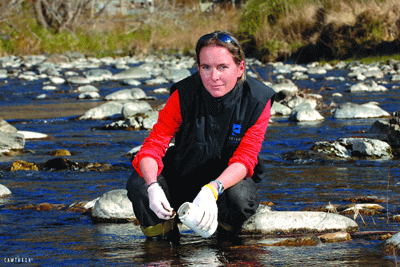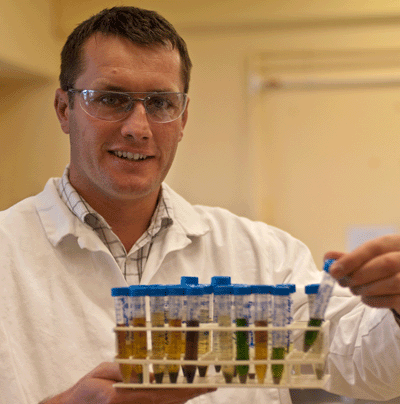By Les Watkins
Microscopic plants from the ocean around New Zealand are poised to provide one of the country’s most profitable exports – containing potentially lethal toxins – with a trading value 50,000 times their weight in gold.
The products containing those natural toxins, which are found in algae, have been grown and extracted at the Cawthron Institute in Nelson.
They have a variety of beneficial uses, including assisting in the analyses of shellfish to ensure they are safe to eat.
Cawthron has been operating for more than 90 years and is the country’s largest independent research organisation. It is one of only a handful of organisations worldwide with the capability to provide the market with the compounds.
“Our process, though, is unique in that we are the only ones able to link the whole process from beginning to end – culturing and producing compounds from our own algal collection prior to extraction and purification and further synthesis,” says acting chief executive Daryl Wehner.
The Institute’s range of products is proving increasingly important for food and pharmaceutical producers and commands astonishingly high prices. Mr Wehner told NZ FOODtechnology:
“These extracted natural compounds represent the ultimate prize in New Zealand’s drive for a high-value export commodity – selling for more than 50,000 times the price of gold.
“A single milligram of one of them, equivalent in volume to three grains of salt, was recently sold to a European country for $5500. Ten milligrams of another was sold to America for more than $45,000.
“A level teaspoonful of these compounds – well, that would be worth several million dollars.
“Sales over the first nine months have exceeded a quarter of a million dollars and we have several large orders already placed awaiting delivery.”
He does not regard this as a ‘significant volume demand’ and adds: “This is very much in its infancy and the real demand is unknown at this point.
Cawthron has spent 15 years developing its expertise in this field – initially concentrating on improving the safety of the country’s seafood industry.
Head scientist Paul McNabb says the risk to shellfish stems from the algae, far too small to be seen by the human eye, which are consumed by many sea creatures, including shellfish.
“Shellfish are filter-feeders – taking in water and filtering out the natural toxins in the algae. But sometimes during the digestive process they can absorb and accumulate toxins which can make people sick – or even kill them.”
Laboratory mice were originally used to test whether or not shellfish were fit to eat.
“But this method was incredibly inefficient,” says Mr McNabb.
“Sometimes mice would die when the shellfish contained nothing of concern for human health and sometimes they would live when there was.
“So we have changed our systems in New Zealand and one of the ways we have done this is to have access to these rare chemicals to enable us to calibrate our instrumentation for testings.
“We have developed new ways of monitoring these toxins and one of the benefits of our work – apart from its applications in the pharmaceutical industry – is the ability to ensure greater safety for shellfish consumers anywhere in the world.
“Now we are developing a business that sells the toxins in their pure form so that other people can use them for analysis and other toxicological sorts of research.”
Collecting the toxins in big enough quantities, however, was a major challenge.
Laboratory services manager, Nico van Loon points out that they are present in very small amounts in the algae, compared to the likes of Omega-3 fatty acids which are present in relatively large concentrations.
This makes extracting them very difficult – “very much akin to finding a needle in a haystack”.
But, says Mr van Loon, the potential return could be phenomenal, with sales to date solely in response to customer enquiries.
“We had initially intended to investigate the worldwide demand for these compounds but preliminary conversations with potential customers have already produced more demand than we can cope with at the moment.”
Daryl Wehner says Cawthron is now considering what capital investment may be needed to enable it to rapidly expand the range of compounds it can provide and to establish wider markets.
“It is still early days in terms of this new but clearly lucrative market opportunity but we are confident we have the skill and ability to make our mark,” he says.
“We have purified a few compounds from a small number of algal species to date but there is no end to the possibilities for producing and extracting others.”
The scientific research in which the Cawthron Institute specialises has been a great asset in shaping New Zealand’s reputation for innovative thinking.
It maintains this country’s algae collection and its algae library was used to rebuild some of the American collection destroyed during floods in New Orleans.
Dr Tim Harwood, one of the institute’s top algal experts was recently awarded a research grant to work with Japanese scientists investigating a toxic algae – never seen before – that bloomed in Wellington Harbour.
Its expertise was also used to identity the toxin on Auckland beaches which two years ago was killing dogs. It is now extracting and purifying similar toxins for use by laboratories overseas to assist in the identification of newly-found toxins.






























































































